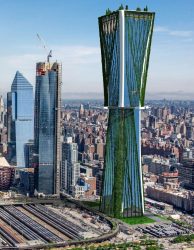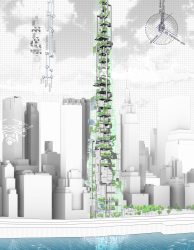
Interview with Paolo Russo
1) Briefly introduce yourself and tell us a bit more about your practice. What do you work on? What are the issues you aim to address in your profession?
I’ve studied at Politecnico di Milano and at the Universidade Técnica de Lisboa. I joined Stefano Boeri Architetti in 2017 and I work as project leader for some of the residential projects now under construction in Europe. Among them Wonderwoods, a mixed use tower in Utrecht and Trudo Vertical Forest, a social housing tower in Eindhoven. Currently, I’m working at the design of Botanica Tower, a project in Milan city center, which is the result of an international competition won in collaboration with the New York based firm DS+R.
2) What is a skyscraper in the 21st century and how can a skyscraper incorporate biodiversity without falling into greenwashing? What are the historical, contextual, social, urban, and environmental responsibilities of these mega-structures?
I think that the architectural typology of the skyscraper hasn’t changed in the last century. What changes are the issues we have to deal with, trying to give answers to requests and answers often posed in advance by the society.
Today we cannot fail to deal with the urgency of the ecological transition of our cities and with the need of a sustainable approach in construction processes.
Biodiversity can be included effectively in the design working together with a multidisciplinary and specialized team that can address contemporary environmental issues, including the lack of biodiversity. Nowadays the design team has expanded, there are many different skills. Professionals from very different fields collaborate daily on the project process. I’ll give you a simple but emblematic example: in Wooderwoods tower project we collaborated with an ornithologist to understand how to integrate bird nests and bat boxes into architecture and we ended up identifying 5 different typologies that will be hosted by the dutch vertical forest.
3) Concerning High-rise and densely populated cities, how do we promote biodiversity with scarce land availability?
It is necessary to focus on the multi-scales of the project, we cannot afford to leave out neither the overall vision nor the single architectural project. The relation with the context is fundamental, the single intervention does not have the strength to initiate significant changes, we must focus on the ability to create a network. When we are talking about biodiversity we must focus on how what we are planning relates with the ecological corridors of the city and of the region. Biodiversity must be promoted in contemporary urban environments through Urban Forestry interventions of different scales, such as a vertical forests, green walls and green roofs retrofitting, and many other Nature-based Solutions that with the contemporary knowledges and techniques can be easily implemented.
4) Which tools & disciplines can come into play when designing a more biodiversity-aware built environment? Which technologies can have a key role in this transition?
The disciplines that should be involved in the process of planning consciously the built environment, with the goal of the ecological transition, are of various type. We work with engineers and designers as well as with agronomist, botanist, ornithologist, arborist, forester, mobility experts, sustainability experts, researchers. Cross-disciplinary approach is the key to address the contemporary issues of the built environment.
As per the Tools, I find necessary to implement programs and technologies that can monitor and collect ex-ante and ex-post data, such as the quality of the air or the heat island effect. Just knowing data we can evaluate changes and benefits of what we have planned, and address correctly what we will need to plan. For example, there are tools that help you with the LCA during the whole design process, allowing the designer to understand what impact on the ecological footprint have a solution rather than another one.
5) Are there any reference projects you could suggest to inspire our community for this design challenge? Why did you choose this specific example?
I would like to answer with two provocations. The first one is the collaged image “The city is approaching a peaceful morning” by Tsunehisa Kimura, 1973, composed of photographs of Manhattan and of the South American Iguazu Waterfalls.
The second one is the theoretical project “Highrise of Homes” by SITE (Sculpture In The Environment), 1981.
6) In your experience, what does it take to win an architecture competition? What about this competition in particular?
Innovation, go for the bold idea and build over it a clear storytelling.





